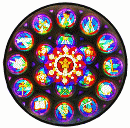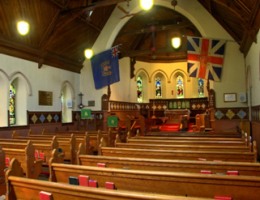
The tile frieze encircles the church interior
Click here for larger version
Photo by Graem Coles.
St. Alban the Martyr Memorial Church, Adolphustown, Ontario, was built in 1884 as a memorial to United Empire Loyalists. The interior of the church is encircled by an exceptionally beautiful tile frieze consisting of sixty-four tiles bearing inscriptions commemorating early Loyalists. Click here for an alphabetical list of tiles with the tile number for each and a biography of the person.
The tiles have long been valued for their historical significance as testimony to lives of early Loyalists but it was only recently, when work was begun on a book to compile biographies of the individuals memorialized that the intrinsic artistic value of the tiles themselves came to be appreciated.
Over the course of three years (2009 - 2011) the sixty-four biographies of the ‘Tile People’ were carefully compiled using many sources including the archives at the United Empire Loyalist Cultural Centre and Museum in Adolphustown and archives and libraries in Napanee, Wellington, Bath and Kingston. Many reference books were consulted including two books published only after the research had begun. Personal correspondence with descendants and internet searches yielded previously unpublished information which could be added to the biographies.
As the biographies slowly took shape it was decided that the book should not be simply a compilation biographies but should include information about the building of the church as well as a section dealing with the tiles as an art form. We had assumed that the patterns and individual inscriptions of the St. Alban's tiles had been hand painted but during the course of our research we learned that they are in fact encaustic tiles. They are rare examples of an ancient art form that had a brief revival in the mid 19th century, and it was during this revival period that the St. Alban's tiles were ordered. By the end of the 19th century production of such tiles had virtually ceased because of the artistic demands and high cost of this labour intensive art form. For ordinary decorative tiles the decoration is painted on using glazes, resulting in a pattern that can wear away easily. With encaustic tiles the patterns are achieved by embedding coloured clays into carved indentations in an unfired tile. The clay composition is then covered with a clear glaze and fired for many hours at high temperatures. The term encaustic stems from a Greek word meaning ‘burnt in.’ Such tiles can only be produced in a studio employing artisans with exceptional molding skills and a knowledge of the colors different types of clays will produce when fired. The result is patterns, and in the case of the St. Alban's tiles also inscriptions, which are integral to the tile itself, producing durability as well as beauty. No paint or colouring, which could fade or wear off, is involved in the process of making encaustic tiles.

A three-tile section of the frieze
Photo by Graem Coles.
Researching the St. Alban's tiles was possible because Rev. Forneri, who oversaw all aspects of the building of the church in the 1880's, kept detailed records. All the original order forms for the tiles were in these records and with the help of tile experts from the Royal Ontario Museum and the Architectural and Ceramic Society of the United Kingdom we were able to identify the source of production of the St. Alban's tiles as a studio and factory founded by Herbert Minton in Stoke-on-Trent, U.K. in 1788.
A trip to Stoke-on-Trent and visits to the Gladstone pottery works and the Stoke City Archives yielded a wealth of information about the 19th rebirth of encaustic tile production. Herbert Minton, one of the best known ceramic and porcelain makers of his time, spent five long years in research at his pottery in Stoke-on-Trent in the 1840's attempting to produce inlaid tiles, endeavoring to replicate handmade medieval tiles created in the 13th Century. Twenty-four patterns such as fleur-de-lys and other Christian symbols were copied from the floor of the Chapter House in Westminster Abbey that had been laid with encaustic tiles that had been made by hand, probably by Cistercian monks, about 1252. Artistic designers created molds of patterns found in the Westminster tiles and, under Minton's supervision, trials were carried out until the method of creating inlaid patterns and lettering in the encaustic tiles manufactured at his works was perfected. There was a lot of trial and error as, when a tile was dried and fired, the clay of the precast main body of the tile and clays used to fill the inlaid pattern indents tended to contract at a different rates. The inlaid patterns could then either shrink and fall out or expand and cause the main body of the tile to crack.
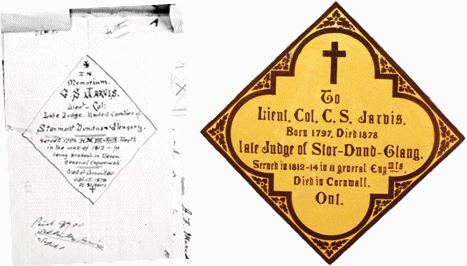
Order for Jarvis tile (marked “paid $7”) and completed tile
Minton began to experiment with coloured clay slips of differing consistency to fill the designs and inscriptions and to apply lustrous glazes to the tiles to enhance the natural colours of various clays. His research was finally rewarded and beautiful tiles with inlaid patterns based on the medieval Westminster tiles, became available. The Minton tile works received many commissions to create tiles for a plethora of neo-gothic churches being built in the United Kingdom at the time. Minton received a commission for the refurbishment of the great Temple Church in London and used tiles patterned on the 13th century Westminster tiles for that project. Minton tiles were also used to restore damaged areas of the Chapter House Floor of the Abbey.
In 1889, Reverend Forneri was able to order from the Minton family tile works the first thirty three tiles for the sixty-four tile wall frieze he envisioned as encircling the interior of the church. The hand-made tiles bearing inscriptions to honour United Empire Loyalist who had settled in Canada from Nova Scotia to Detroit were carefully packed and shipped from Stoke-on-Trent to Adolphustown. The tiles were all sponsored by descendants of the Loyalists who paid seven dollars for a buff tile and twelve dollars for a blue tile. This sum covered the production cost of the tile, transportation by land and sea and installation in the church.
Reverend Forneri intended it to be a wall of honour to the Loyalists. We know the details of his efforts to contact descendants, the cost of each individual tile and all the shipping details because Reverend Forneri kept meticulous records of his efforts. He used an old church ledger and entered carefully scripted details in columns, headed, Bride, Groom and Witness. His precious scrapbook is carefully preserved in the Anglican Church Diocese office in Kingston, Ontario.
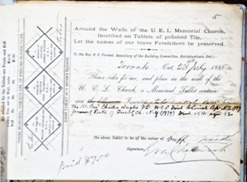
Order for Inglis tile
Other Encaustic Tiles
Aside from the St. Alban's tiles, the only other significant installations of Minton encaustic tiles now extant in North America that we have been able to identify to date are found in the parliament buildings in Quebec City and the Capitol building in Washington. If you happen to be in London taking a tour of Westminster Abbey be sure and examine tiles on the floor of the Chapter House, Minton's original source of inspiration for the St. Alban's tiles. If you are taking a tour of the Capitol building in Washington the guide will point out the rare and beautiful encaustic tile floors in some of the hallways and rooms. Pause for a moment on your tour to reflect that a similar artistic treasure can be found in a small church in Adolphustown, Ontario.
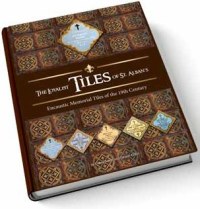
A bound hardcopy of the book
Book Published
With the help of a generous Trillium grant, Diane Berlet and Graem Coles have published a book entitled The Loyalist Tiles of St. Alban's: Encaustic Memorial Tiles of the 19th Century.
This volume includes the biographies of the sixty-four ‘Tile People,’ an individual full-page photo of each tile, and a section on the production and installation of the St. Alban's tiles. The book also includes coloured illustrations of Christian symbols and other details found on the tiles of both the 13th Century Westminster Abbey Chapter House floor and those on the walls of St. Alban's for comparison.

